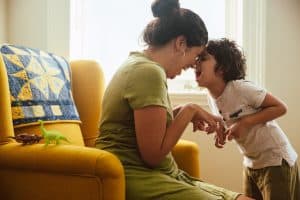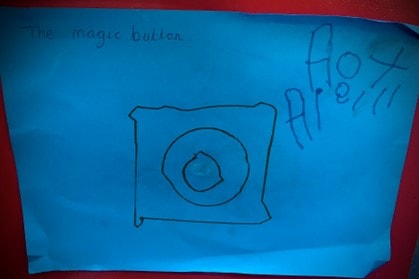Empowering Children Through Listening with Love
by Tamsin Grimmer on July 14
7 min read:
Many early childhood educators want to give their children a voice and listening to children has become a very popular notion within early childhood in the last 20 or so years. I believe that listening to young children, genuinely consulting them and ascertaining their views, is part of developing a loving pedagogy and can enable our children to feel empowered. It might be helpful to think about what we mean by listening and how we can actively listen to our children.
Sonia Mainstone-Cotton describes truly listening to young children as, “a two way act of intent and purpose”, moving beyond just hearing words to fully responding to their words, actions and behaviours. If we consider how we hear different sounds and can tune into and out of some depending on where you are and the context you are in. For example, if you are sitting in your kitchen doing some paperwork and the fridge is humming, you probably do not even notice it and can tune out of the sound; but if someone were to comment on how loud your fridge is, you would immediately tune into the sound and notice it a lot more. Our brains can distinguish between sounds we hear and sounds we need to listen to.
The same is true for listening to children. Sometimes we can be so used to hearing our children’s voices that they become a little like background noise and we forget to really listen to them. This is linked with attunement, when we are actively listening we are able to not only tune in to any words or sounds, but also to respond sensitively to the child’s body language and way of being. In this way we are attempting to better understand our children. You may have come across the Mosaic Approach, a form of research using several methods to listen to young children, which seeks to see the world from a child’s perspective (Clark and Moss, 2017). Underpinning this approach is the notion that young children are experts in their own lives and have a wealth of ideas and experiences that we, as adults, should value and seek to gather and understand.
Agency
Offering children agency goes somewhat further than just listening to young children. Agency could be described as believing that children are competent and capable of initiating their own learning alongside enabling children to feel and believe that they can have an impact on their own lives. It is when Article 12 of the UN Convention on the Rights of the Child is fully put into practice, rather than having lip service paid to it (Unicef, 1989). This article states that, ‘Every child has the right to express their views, feelings and wishes in all matters affecting them, and to have their views considered and taken seriously.’ So this is about children recognising that they have a voice and knowing that using it may result in action, to empower children to be an active agent in their own experiences. And it is about adults being an advocate for children to ensure that they have a say and that their voice is heard and acted upon.
An example of this could be when we organise the learning environment in such a way that enables children to access resources without their needing to ask an adult. Through listening to children we can try to gather their views on the resources and experiences that they enjoy and want more access to and can then tailor our provision accordingly. By affording children agency we are handing the control over to them, allowing them to be independent and empowering them to feel listened to and valued. The more we do this, the more we become advocates for them, promote their needs and help their perspective to be seen.
100 Languages
There are lots of different ways that young children communicate and we can listen to them. This links with the inspiring poem by Loris Malaguzzi, The Child is Made of One Hundred (Edwards, Gandini and Forman, 2012). Language is part of the story, but not the whole story because most of the ways we listen to our children is through observing them and noticing the sounds they make, their body language and how they make eye contact or what they are looking at. We can observe any gestures they make – perhaps they can point, or use sign language. Sometimes we can listen to our children through their creations, pictures or drawings, but mostly we will be listening to them through their behaviour. Because behaviour is communication. We can observe what they do, what their interests are, where they play and how long they play there. If a child spends a long time in a certain area or with a particular resource we can assume they like it. We can notice who they play with too and mentally note their interactions.
Of course, we can also listen to what children actually say and how they say it, however very young children are just learning language and many children will find language difficult or have trouble communicating and we will need to listen to them via the methods shared above. They may need additional support and nurture from us – the world can be a frightening place when we don’t understand what’s going on around us or we are unable to communicate our needs.
Empowering children
Children are living in a world where they have very little power and are mostly ‘done-unto’, meaning that they do not have much say in what happens to them. Adults plan and control what they eat, often what they wear, where they will go and who they will meet. Children may feel powerless at times and adopting a loving pedagogy will keep their needs central to our provision and ensure we are seeing the world from their perspective. Offering children choices is a way of giving them a voice, listening to them and offering them a little bit of control over their lives. In adopting a loving pedagogy educators take time to become attuned to children and remain sensitive to their needs. This, in turn, enables children to feel understood and offers them agency and a voice. Feeling loved, safe and secure empowers children and enables them to be ready to learn.
Ways that we can empower children through listening with love include:
- Get down to their level and try to see the world through their eyes.
- Take time to become attuned to children.
- Listen to their words, when possible act upon this and take their views into consideration.
- Ask genuine questions – not questions we already know the answer to!
- Notice their behaviour and actions, facial expressions and body language. With young children mirror their actions or body language and comment or provide a running commentary.
- Observe them whilst playing alongside and act as a co-player when invited to join their play – resist the urge to take over!
- Offer children choices throughout the day.
- Plan sessions with their interests and fascinations in mind.
- Include them in the conversation, never talk to other adults over their head.
Lexie’s story, Denmead Infant School
The Magic Button was created by Lexie and embraced by Rabbit Class. Lexie drew a button and told me it was magic. I stuck it on the wall and called it ‘The Magic Button’. A ripple went round the class and 6 months later we are still pressing the magic button! Anything can happen when you press The Magic Button from a new sound appearing to the head teacher popping in! Lexie’s drawing could have gone in the bin and with it a way to engage and excite a class of reception children. The Magic Button is special to this class and unites us together. It’s only for us, it’s special, it’s ours and it helps build a classroom of love.
This case study was originally shared in my book Developing a Loving Pedagogy (Grimmer, 2021) and it explains how Lexie was empowered by the way her teacher embraced her picture. The learning environment and ethos in the classroom meant that Lexie knew in sharing her picture with the teacher that it would be valued. In fact, it was more than valued and within the classroom it was as if it went viral! The Magic Button became a magical doorway for many adventures and was a source of inspiration in the classroom for the best part of the school year. Lexie felt valued, her idea was shared with others, including the headteacher. Her creativity and magical thinking was celebrated and other children in the class would see, from this example, that their own ideas would also be treated in this way, affording them agency too.
Lexie was empowered through listening – and we can do that too for all of our children – if we listen with love.
References
Clark , A. and Moss, P. ( 2017) Listening to Young Children: A Guide to Understanding and Using the Mosaic Approach. London: Jessica Kingsley.
Edwards, C., Gandini, L. and Forman, G. (2012). The Hundred Languages of Children: The Reggio Emilia Experience in Transformation, 3rd edn. California: Praeger.
Grimmer, T. (2021) Developing a Loving Pedagogy in the Early Years. Abingdon: Routledge.
Mainstone-Cotton, S. (2019) Listening to young children in early years settings: a practical guide. London: Jessica Kingsley.
Unicef (1989) United Nations Convention on the Rights of the Child. Available at www.unicef.org.uk/Documents/Publication-pdfs/UNCRC_PRESS200910web.pdf
More about Tamsin Grimmer
Tamsin has written several books aimed at educators including:
- Developing a Loving Pedagogy in the Early Years: How Love Fits with Professional Practice
- Observing and Developing Schematic Behaviour in Young Children
- School Readiness and the Characteristics of Effective Learning
- Calling All Superheroes: Supporting and Developing Superhero Play in the Early Years
- Supporting Behaviour and Emotions
- Nurturing Self-Regulation in Early Childhood
You can connect to Tamsin via:
- Twitter: @tamsingrimmer
- Facebook: Tamsin Early Years Consultancy
- Website: www.tamsingrimmer.com
- Email: tamsingrimmer@hotmail.co.uk
To hear Tamsin chatting with Jules from our education team, about developing a loving pedagogy, you can listen to the ‘Developing a Loving Pedagogy in Early Years Settings’ FSF podcast episode.
